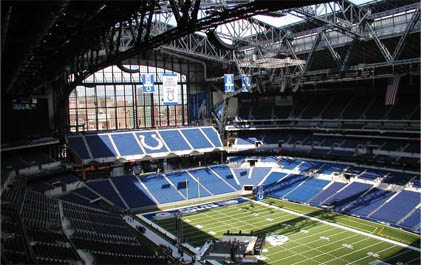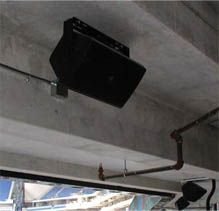Game On

Lucas Oil Stadium Networked For The Future Of Sound
INDIANAPOLIS, IN—Is a 1.8 million square-foot venue with seven levels, seating capacity of 63,000 for football and up to 70,000 for basketball, conventions, and concerts, 137 corporate suites, and audio equipment that includes 342 Crown amplifiers, 96 JBL VerTec VT4889DPAN line array loudspeakers a stadium or a small Midwestern city?
Lucas Oil Stadium’s retractable roof had little effect on audio networking or tuning, although the decision to permanently suspend the main line array cluster, featuring JBL VerTec VT4889DPAN powered line array elements, made the need to close the roof during inclement weather more pressing. (Inset) The Lucas HiQnet system represents the most extensive use of System Architect as the primary control of a vast audio system that features a number or Harman Professional brands. catering also to the aforementioned basketball, conventions, and concerts, is that massive place. Lucas sports a Harman Professional HiQnet audio system with configuration and control via HiQnet System Architect. The system was designed by consultants Wrightson, Johnson, Haddon, and Williams of Dallas, TX, with integration by ESCO Communications of Indianapolis, IN.
Featuring one of the largest HiQnet deployments in the world, Lucas represents the wave of the future, says Bradford Benn, director, application engineering for Crown Audio. “WJHW designed a great system, bringing together ideas that previously had been used separately in one large system, maximizing the power and flexibility of the system. Everyone is looking at this stadium and its converged network. Lucas isn’t just big—as stadiums go this is about double the typical size—it’s a major tech statement.”

- in the house. We set up three networks in the building just for audio, two separate CobraNet networks and one for control only. This was the first time on a project of this size that we were tied into the base building. This was the entire network for the whole facility from point-of-sale to scoreboard and word processing, and that was a big first.”
- Most challenging in this scenario, Benn said, was network management. “Generally, I work directly with the contractor to set up the switches,” he said. “At Lucas, ESCO or WHJW had to contact the network provider to make changes, so our planning was more involved.”
- The Lucas HiQnet system represents the most extensive use of System Architect as the primary control, explained Rick Kreifeldt, vice president of Harman’s System Development and Integration Group, whose team coordinated development of the protocol with the Harman Pro brands. “There are 218 master panels and 118 custom panels with sophisticated control taking place by different users with different accesses,” he said. “There’s a planogram of the system so if a part of it goes ‘red’ the operators can dive in and see what’s going on; there’s extensive health monitoring of the system and the amount of training is at the upper minimal level, done by ESCO along with Brad [Benn], because it’s very visual and intuitively understood.” Kreifeldt’s group, focusing on core technical
A closer view of the JBL line arrays. development, is extended by Harman’s brand engineers who write the product plugins for System Architect. “It’s not just five guys here together; it’s engineers around the globe,” Kreifeldt said. “It takes into account what can you do with electronic communication with a distributed team working together and Lucas is an example.”
The go live date was a scant two weeks after release targeted release date. “It was frenzy and I’m proud to say we hit the exact release date,” Kreifeldt enthused. “Brad worked well in advance to sort through the client’s needs and feeding them into our requirements to show early alpha and beta features, several of which were developed in the three months prior to opening.”
A daily selection of the top stories for AV integrators, resellers and consultants. Sign up below.
